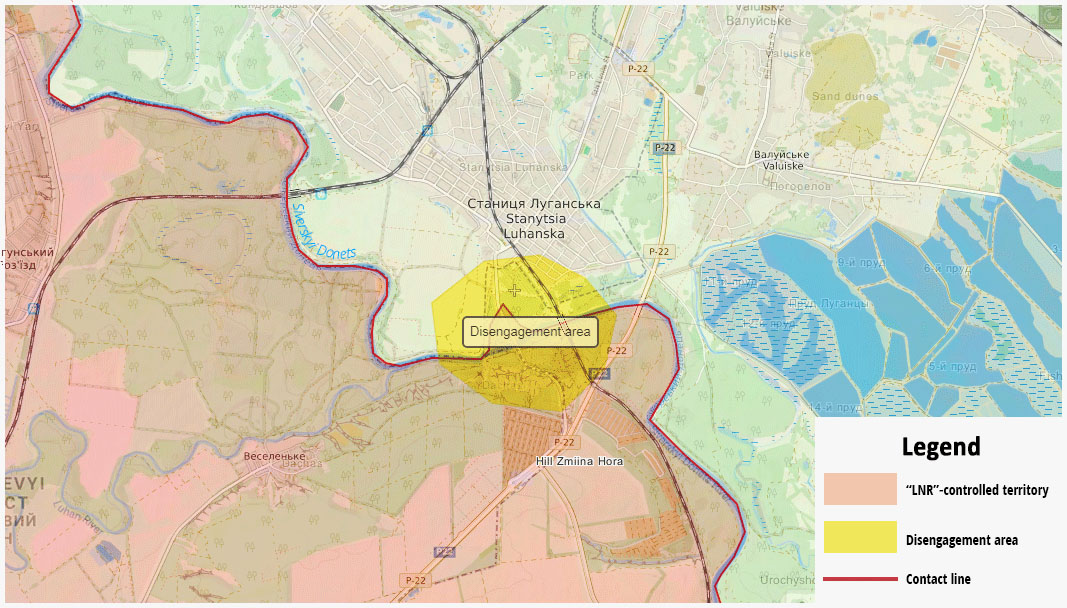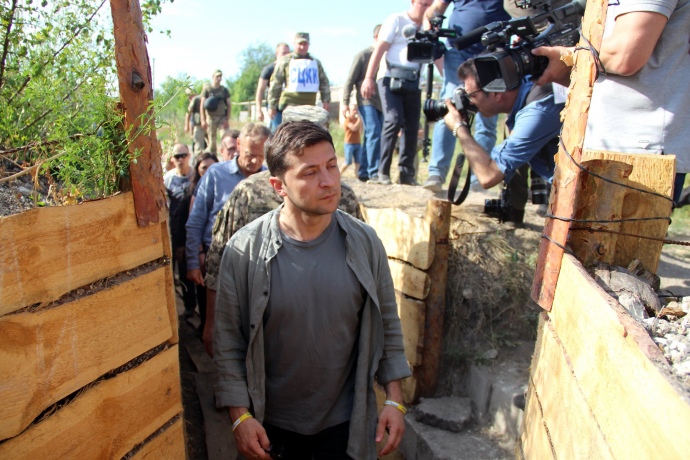What can the consequences of such a total disengagement be?
Disengagement at Stanytsia Luhanska

Three disengagement zones in the Donbas were agreed in late September 2016 by the Trilateral Contact Group (Ukraine, Russia, OSCE) for the Donbas conflict settlement (TCG). The TCG regularly negotiates issues of the ongoing conflict in the Belarusian capital, Minsk. These were the areas near Stanytsia Luhanska and Zolote (Luhansk Oblast), and near Petrivske (Donetsk Oblast). The agreement envisaged the withdrawal of forces from the contact line to create three security areas at least one kilometer wide and deep.
In October 2016, the disengagement took place near Zolote and Petrivske. Due to military activities in the area, Ukrainian troops had to return to their abandoned front-line positions shortly after.
At the end of June 2019, a disengagement near the government-controlled town of Stanytsia Luhanska took place. Both Ukraine and the Russian-backed Luhansk People's Republic (LNR) forces reportedly pulled out troops and started dismantling fortifications in the area.
-
Read more: Disengagement in Stanytsia Luhanska: path to peace or Ukraine’s further territorial losses?
As well, Ukraine started repair works at the blown-up span of the bridge over the Siverskyi Donets river in the buffer zone to provide better conditions for the Ukrainians crossing the contact line at the Stanytsia Luhanske entry-exit checkpoint.
However, the area of Stanytsia Luhanska was relatively calm since early 2015 even without establishing a safe zone as compared to other stretches of the front such as Svitlodarsk Bulge or Donetsk or Mariupol.
And just several hours after Zelenskyy welcomed the Stanytsia Luhanska disengagement, Russian hybrid forces hit a Ukrainian medevac vehicle with a missile in Donetsk Oblast, killing two servicemen including military doctor Iryna Shevchenko.
Zolote and Petrivske

Zelenskyy didn't stop his peacemaking efforts with Stanytsia Luhanska's disengagement and said on September 13 that the next stage of the peace process in the Donbas would be the withdrawal of Ukrainian troops in Petrivske and Zolote.
On 1 October he announced both mutual disengagements as scheduled on 7 October as all participants of the TCG agreed on it.
The Special Representative of the OSCE Chairperson-in-Office in Ukraine and in the TCG, Ambassador Martin Sajdik in his statement confirmed the decision and added,
"The TCG members [Ukraine, Russia, OSCE] and representatives of certain areas of Donetsk and Luhansk regions had agreed on the so-called Steinmeier formula."
The latter piece of news fueled protests in Ukraine since many Ukrainians see the implementation of the formula which envisages that a law defining the" holding local elections in the occupied areas without clarifying a way to capitulation. Zelenskyy hurried to deny the agreement, stating that the accords on the Steinmeier formula were not signed and were "pending approval."
Read also:
- “Steinmeier’s formula” seen as state capitulation, protested in Ukraine
- Protests against Steinmeier’s formula spread in Ukraine, “movement against capitulation” founded
- Protests against “Steinmeier’s formula” gather largest crowd since Euromaidan
On 7 October, the target day set for disengagement in Zolote and Petrivske, Ukrainian Foreign Minister Vadym Prystaiko informed that the process was postponed,
"Unfortunately, you know that Petrivske and Zolote came under fire a few days ago and, as you may remember, we agreed to start the disengagement on the seventh day after peace was maintained on that particular site and no shelling was recorded," said the FM.
As well as the minister assured that Ukrainian would be able to take up its abandoned positions after the upcoming withdrawal "if we see that the other side to a conflict is not fulfilling, moreover, God forbid, it plans some aggressive actions"
Meanwhile, Dmitry Peskov, Russian President Putin's spokesperson, once again called the Donbas war "an internal Ukrainian conflict" and said that Russia cannot guarantee the withdrawal of its forces since it sees itself as a guarantor of Minsk action plan and "the Kremlin is not a party to this conflict."
“The Kremlin, certainly, has a particular influence on the Donbas republics. But you know that the republics of Donbas, in this case, are independent subjects in the settlement of this conflict,” Peskov said.
Total disengagement
On 21 September, Ukraine's Defense Minister Andriy Zahorodniuk announced that the Armed Forces were crafting a plan of disengagement of manpower and weapons from the entire contact line. He assured, “It’s not a retreat, it’s disengagement."
"We’ve talked to the soldiers, to the General Staff, and nothing will be done without due preparation … Of course, we’ll make sure that the other side does the same thing.” said the minister.
On 4 October speaking on a political TV show, FM Prystaiko specified that the idea of the total disengagement belongs to President Zelenskyy. It is going to be carried out after troops have been pulled back in the first three areas of Stanytsia Luhanska, Zolote, and Petrivske.
"After these three areas, he plans the disengagement along all 400 km so that people stop dying along the 400 km, little by little. I believe he had no moral right... to wait longer," Prystaiko said.
Risks
The co-head of the European Solidarity parliamentary faction, Iryna Herashchenko, pointed out that Russia doesn't return to Ukraine the city of Debaltseve, which should remain under the Ukrainian control under the Minsk peace agreements but was captured by the Russian-hybrid forces in February 2015 shortly after the signing the so-called Minsk-2.
According to her, signing the new agreements out of touch with the key component which is security poses risks to the civilians living near the contact line and to the Armed Forces which are going to pull out troops from the well-equipped strongholds to open fields without well-established fortifications in many areas.
The so-called "gray zone" is a narrow strip of no man's land, a buffer area along the entire front line. In some places, it is only a few hundred meters wide, elsewhere it is broader and reaches a few kilometers. The total disengagement would extend the gray zone so that multiple inhabited settlements would end up without effective Ukrainian control, risking to occupied at any time.
The total number of such towns and villages depends on the depth of the withdrawal which would be agreed. For example, the 2014 Minsk Protocol (Minsk-1) envisaged pulling heavy weaponry 15 km back to create a 30-kilometer buffer zone. Here is the map showing the gray zone as it was back in 2016:

Commenting on the agreed Petrivske and Zolote disengagements, President Zelenskyy said on 1 October,
“I want to reassure the local citizens; I guarantee personally that you will be protected and the disengagement will not influence your security. The example of this is the situation in Stanytsia Luhanska, where the successful disengagement of the forces took place; the pedestrian bridge is under restoration now and we plan to build the fundamental bridge until the end of November.”
Unfortunately, Stanytsia Luhanska can't be a case since the military activity has been low there for years and we don't really know what plans the Russian-hybrid forces have elaborated for Zolote or Petrivske. Moreover, the total disengagement would open great opportunities for any Russian offensive operations since the defenseless settlements in the gray area would be easy prey. Moreover, the new Ukrainian defense line would require lots of fortification work.
Civil volunteer and veteran Myroslav Hai fears that further disengagement may demoralize soldiers, who can't understand why they should leave their own positions, which "they had been sent to reconquer, where every centimeter is soaked with the blood of their brothers-in-arms... Moreover, there are the well-equipped blindages, in which not only the state and volunteers invested money, but the soldiers themselves."
FM Prystaiko promised that the strongholds will remain intact after the withdrawal for Ukrainian troops to return if the militants violate the agreements. However, as we could see it in Stanytsia Luhanska, the dismantling of the fortified positions comes next after the disengagement.
Meanwhile, the war goes on in the Donbas. In September, 11 Ukrainian soldiers were killed and 40 wounded in action.
A sustainable ceasefire is one of the conditions of the disengagement, that's why Ukraine refused to start the withdrawal in Zolote and Petrivske on 7 October citing fire attacks in previous days - a Ukrainian serviceman got wounded on 4 October near Petrivske. In reply, Russia's Ministry of Foreign Affairs called on Kyiv to start the process anyway, alleging that postponed disengagement "threatens with a dangerous escalation of tension on the line of the contact."
In his efforts to resolve the conflict, Zelenskyy risks assuming disadvantageous obligations unilaterally without any guarantee of reciprocal steps by Russia. Instead, the puppet governments of the so-called Luhansk and Donetsk "people's republics" (LNR and DNR) - Russia-run pseudo statelets - are acting as Ukraine's counterpart giving the promises of tit-for-tat measures. By doing so, Ukraine is entering on the path of accepting Russia's role as an uninvolved spectator in the conflict, initiated and fully controlled by Russia until now. Thus, the subject of de-occupation is going off the table.
Read also:
- “We’re scared for our lives!” Pro-Ukrainian population near demarcation line against disengagement of Ukrainian troops in Donbas
- The real problem with “Steinmeier’s formula” and the Russo-Ukrainian war
- Portnikov: President Zelenskyy is deceiving himself and Ukrainian people
- Protests against “Steinmeier’s formula” gather largest crowd since Euromaidan
- Moscow commentator: Kremlin believes Ukraine is about to surrender
- The “Steinmeier Formula”: Zelenskyy’s huge mistake
- Protests against Steinmeier’s formula spread in Ukraine, “movement against capitulation” founded
- “Steinmeier’s formula” seen as state capitulation, protested in Ukraine
- Can Zelenskyy “stop the war in Donbas” and how will the Steinmeier formula affect Ukraine
- Disengagement in Stanytsia Luhanska: path to peace or Ukraine’s further territorial losses?
- People living near demarcation line extremely worried about withdrawal of Ukrainian troops

